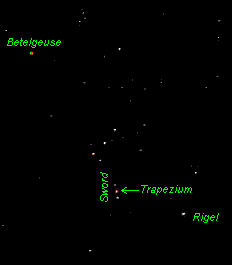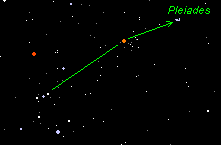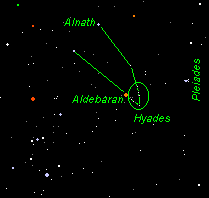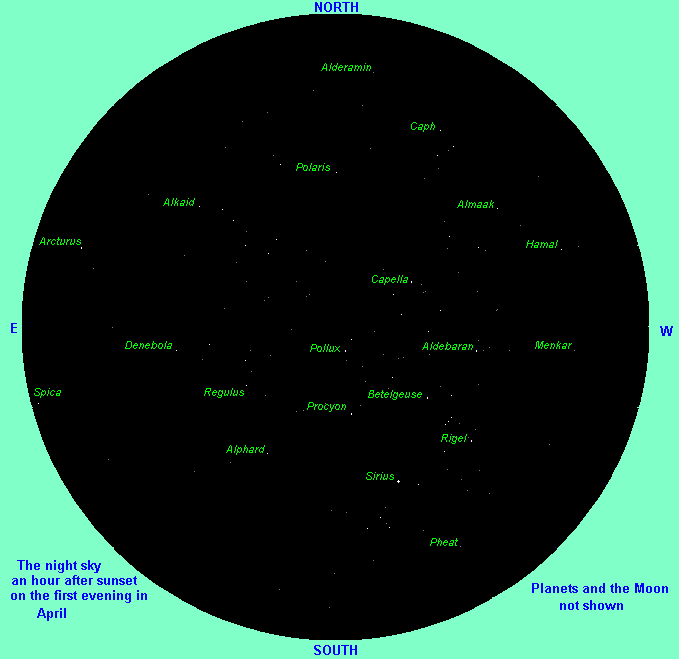This month we have a meteor shower but before we get to that, let's do some star gazing!
April is often associated with birth so I thought that the "birth of stars" would be an appropriate theme for the April Night Sky this Month. Stars are made of matter and all matter has mass. All masses are attracted to other masses by the force of gravity. Eventually this attraction creates a nebula - a tenuous (that means "thin") mixture of gas and dust. Stars are born when enough matter accumulates into a tight ball. As the density at the center of the ball increases, so too does the pressure and heat. Eventually the heat and pressure reach a point at which the nuclei of atoms, mostly hydrogen, fuse. This nuclear fusion is what powers a star so, when it begins, "a star is born".
The April night sky displays a variety of young star in various stages of infancy. Let me show you where they are found while I tell you a little about their young lives.
|
The Orion Nebula, also called "the Great Nebula of Orion",
is about 1500 light-years away and about 30 light-years wide.
It's so big that it spans most of the area of the sky that we call Orion. Most of Orion's stars are on "our side" of the nebula so those stars are not obscured by it. However, a tiny cluster of stars called Trapezium is actually in the nebula and the light from those stars helps us to see the nebula. To find it you first find Orion's "sword", a line of stars that dip down from his belt, along his right side. His sword consists of three "stars" roughly of magnitude 6, 5 and 4 in that order when counted from top to bottom (north to south). The sixth order of magnitude is about as low as you can see with the naked eye on a clear, moonless night, so you may not be able to see the star at the top of his sword. That's OK because it's the middle "star" you are looking for. On a very clear night you can barely see a fuzzy image for Trapezium. That's the Great Nebula of Orion! To the naked eye it's just a blur but with binoculars you can see some detail and with a telescope you can see lots of detail! | 
|
The Great Nebula of Orion is our nearest star nursery. Inside this nebula stars are "born". Indeed, the stars of the Trapezium cluster were born there pretty recently. ("Recent" in astronomy terms.) As the millions of years go by, the nebula is absorbed, and new stars are born. In other words, as the Great Nebula of Orion ages, the nebula will disappear and be replaced by more stars. The gravitational tug of other stars passing by will eventually disrupt this tight cluster of young stars turning them into an open cluster.
| The Pleiades are an example of such an open cluster. To find them, extend a line from Orion's belt, through Aldebaran and go a bit farther while adding a small amount of southerly tilt to it. You'll come to a curious clump of stars with a collective magnitude of about 1.6 but they will appear dimmer than that because the light is "shared" among many individual stars scattered in a group. That's the Pleiades. The Japanese named this star cluster "subaru" and the emblem for the Subaru car company is a stylized version of the cluster. | 
|
This famous star cluster is often called "The Seven Sisters" because on a clear night a person with average vision can make out seven stars in the Pleiades. In fact, there are hundreds of stars in this cluster. Currently, the Pleiades are about 380 light-years away and the entire cluster is about 13 light-years across. A telescope shows that there is still considerable amount of nebula around the stars of the Pleiades. Calculations, based upon the rate of the stars' motion, show that the Pleiades star cluster is about 100 million years old and in about 250 million years they will have drifted so far apart that they will no longer be considered a cluster at all. At that time these stars will have become individuals, each with its own path through the sky.
|
For an example of what that might look like you need look no farther
than the Hyades. This is a very open star cluster that makes up
most of the "V" in the face of Taurus. The Hyades are
made of many stars of reasonable magnitude, some as bright as
3.5 magnitude. I drew a green circle to cover most of the Hyades, but some members
extend outside this boundary.
Aldebaran is not part of the Hyades. Aldebaran is only 68 light-years away but most stars of the Hyades cluster are twice that far from us. The Hyades and Aldebaran just appear close together due to the line-of-sight effect. The Hyades are older than the Pleiades so you won't find any nebulosity among the stars of the Hyades cluster. The stars in the Hyades have had longer to drift apart so you see them as more spread out than the Pleiades. Also, the Hyades are closer than the Pleiades and that makes the Hyades seem more separated than the more distant Pleiades. | 
|
Starting next month the Pleiades, then the Hyades and eventually the Great Nebula of Orion will become lost in the glow of the setting Sun. Take some time this month to view these sights and remind yourself about how stars are "born and leave the nest".
Oh, I almost forgot to mention this month's meteor shower!
The Lyrids meteor shower begins around April 19th, reaches its
peak on the 22nd and is over by April 25th. This is not a particularly
good shower, averaging only 10 meteors per hour, but anything
can happen. If you have nothing better to do at around 3 o' clock
in the morning during those nights, step outside and watch the
skies. At that time Lyra, the "source" of the Lyrids
shower, should be overhead. The parent comet of this shower
is Comet Thatcher. (No relation to the former Prime Minister of
Britain.  )
)
|
Your sky map for the month of AprilSpecifically, this is the view of a clear sky from a latitude of 37N. Star-gazers farther north, such as in Minneapolis, Chicago and most of Europe, will have more of the northern sky visible and the southern sky will be obscured by the horizon. Vice versa for those who are farther south. The stars will not change position relative to each other, however, throughout the month, the Moon and planets will wander, so they are not shown. Only objects of magnitude 4.0 and brighter are displayed. Here's a reverse color image of the map that will be easier on your printer. |  |
On the 2nd of April 1845 the first photo of the Sun was taken. Of course, that required special filters.
Frank Drake began Project Ozma, the first search for extraterrestrial radio transmissions, on April 11th 1960. He found nothing.
One year and one day later (April 12th, 1961) Yuri Gagarin became the first Earthling in space. He completed one orbit of our world in his spaceship Vostok 1.
Twenty years later (April 12th, 1981) the first Space Shuttle,
Columbia, carried Robert L. Crippen and John W. Young
into space. Two days later they reentered the Earth's atmosphere
and glided to a landing, like a plane, proving that the Shuttle
could be reused for further flights. (OK - that flight only proved
that the Shuttle could return as if it could be ready for further
flights. It took the second flight to prove it was a reusable
spacecraft.  )
)
The Hubble Space Telescope was deployed on April 25th 1990. Four weeks later the first images from the scope showed there was something seriously wrong with the optics. It was later determined that years before, during production, a misplaced fleck of paint had introduced an error into the curvature of the 2.4 meter mirror - making it too shallow by 0.002 millimeters! This caused "spherical aberration" and it was impossible to focus the scope. Some projects could continue but the scope was unable to carry out its complete mission. In December 1993 the crew of the Space Shuttle Endeavour captured the scope and repaired it by introducing an extra optical aid that acts like corrective glasses.
I hope you found the Night Sky this Month to be helpful and educational. I invite you to return here monthly for new information.